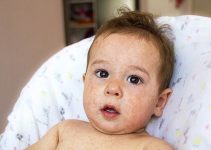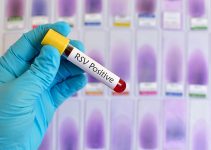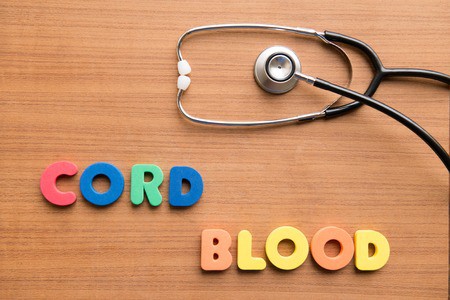What is Fever?
During the first year of life, most babies will get fever at some point of time. As a parent it is rather alarming when you pick up your little bundle and find his skin flushed and hot to touch. As soon as you touch them, you can sense that the baby has fever. But when is it categorized as fever. Fever is defined as a rectal temperature of more than 100.4 degree Fahrenheit. If your baby is warm and very cranky and the thermometer shows just 99 degrees then it is not technically a baby fever even in the smallest of babies. Body temperatures in babies rise for the smallest reasons like a warm bath, being overdressed and overheated, unusual physical exertion etc. The time of the day also affect the body temperature and it tends to rise slightly in the evenings and night and comes back to normal in the mornings. You must still wait and watch before giving any medication or rushing to the doctor.
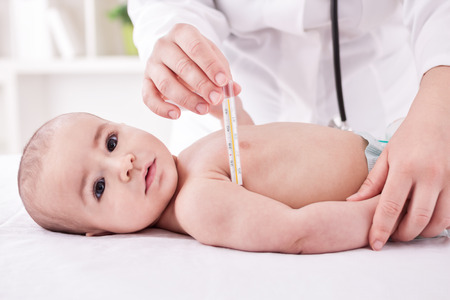
How To Measure Temperature in Babies?
Firstly know the thermometers that are used to record the temperature. There are two types- digital and mercury. For babies it is recommended to use a digital thermometer which is more accurate. Mercury thermometers are preferred for adults as there is a risk of the mercury leaking and poisoning if the glass is broken.
There are three ways that infant temperature can be measured – Orally (mouth), Rectally (rectum) and Axillary (arm pit). Rectal temperature is considered as the most accurate way of measuring a baby’s temperature. Oral or axillary mode of measurement may also be tried but in a baby or a toddler it is very difficult to keep the thermometer in the correct position till the temperature gets recorded.
In order to measure the rectal temperature, use baby supplies like rectal thermometer and clean it properly first either by washing with soapy water or using an alcohol swab. Position the baby on the back and hold both the legs towards the chest to expose the diaper area. Now apply a little petroleum jelly on the tip of the thermometer and insert is slowly into the anal opening for upto one inch. Hold the thermometer in place till you hear the beep sound. Then gently remove the thermometer and record the reading. Clean the baby’s anal region with a wet wipe.
Normal Temperature:
In a baby the normal temperature range is between 97 degrees to 100.3 degrees Fahrenheit. A rectal temperature of more than 100.4 degree Fahrenheit is considered as fever. 99 degrees reading is normal fever for infants.
Causes of Baby Fever
Fever in babies is a symptom or manifestation of an internal illness most likely an infection. When the body is attacked by a bacteria or virus, the immune system fights it off and this is manifested in the form of a raised body temperature or fever.
Babies get fever after a vaccination shot which is completely normal and is notified by the doctor in advance. The vaccination is basically passive immunity where an antigen is inserted into the body to generate an immune reaction and antibodies which will protect the body against such infections.
The commonest cause of fever in children is colds and viral infections. Other reasons that need to be ruled out first are warm room, being overdressed, warm bath and heatstroke.
Other infections that can give rise to fever are pneumonia, urinary tract infections, ear or throat infections. At times serious problems like meningitis or blood bacterial infection may also present with fever.
Signs and Symptoms of Fever in Babies
- Raised body temperature
- Flushed and red skin
- Radiating heat when you pick up your baby you can feel the heat
- Poor eating
- Disturbed sleep
- Weakness and lethargy
- Lack of interest in playing
- Clinginess and desire to be carried all the time
- Convulsions and seizures if the fever is uncontrolled and crosses 104 degree Fahrenheit
How To Soothe My Baby When He Has Fever?
When a baby gets fever, the first few things that you should rule out are whether he is overdressed or over heated. If all is ok check the temperature by one of the methods discussed above. If the thermometer confirms that the baby has a fever then the first thing to do is consider giving a fever lowering medicine like acetaminophen or ibuprofen. Keep a record of the fever. Baby fever chart can be discussed with the treating pediatrician. The medicines should be given in correct and calculated doses which are determined based on the weight of the baby. Never use home spoons or approximate measures when giving the baby medicines. Their little bodies may be harmed by the slightest of over dosages.
Fever causes the body to radiate heat and can make the child easily dehydrated. In order to prevent this you must ensure that the hydration is maintained. Give your baby lots of fluids and water. If the baby is more than 6 months of age, you can give him fresh fruit juices like orange. If your baby is only a few months old, then give him more of formula and feed him often.
When the baby is running a fever, try to keep the room cool and avoid overheating. Wear him loose and comfortable cotton clothes. Never over dress a baby thinking that he may be feeling cold. The fever generally breaks out into a sweat. Make sure to wipe it off immediately.
Keep a close watch on the activities of the baby rather than on the thermometer. Many times a baby with 103 degree fever may be playing nicely where as another one with 99 degrees may be really fussy. So you should treat the symptoms and not the numbers. The reason is fever is considered to be a healthy response where the body is trying to fight off the infection and prevent the entry of microbes in the body. It is the sign of a healthy and normal functioning immune system.
In high fever, try cold sponging by dipping a square napkin in cool water and applying it on the baby’s forehead. This home based method is sure to bring down the temperature.
Many times, when the fever shoots up, the baby may have a febrile seizure. In that case you need to rush to the hospital immediately.
When the baby has fever one thing that you must never do is rub alcohol. It can be dangerous to the baby as it may cool him down and raise the temperature abnormally. Also you must remember never to give a baby aspirin in order to lower the fever.
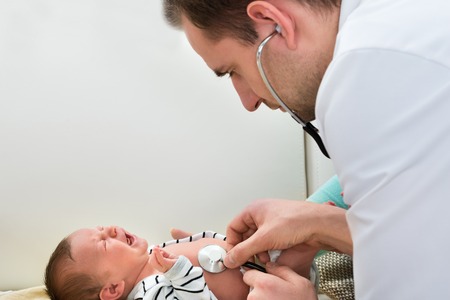
When to Call the Doctor?
Most of the cases of fever will be viral in nature and get resolved with fever lowering drugs. But if the fever is associated with
- Diarrhea
- Vomiting
- Rash all over the body
- Chills
- Febrile Seizures – They are convulsions coming on due to very high body temperature. The episode may last for a few seconds to one minute. The body will stiffen and the eyes get rolled up. It is very scary for the parents to see the child in that state. Most cases with febrile convulsions recover normally without any long term complications.
- Signs of dehydration like depressed anterior fontanels and dry mouth
In all such cases you should see the doctor as the cause of the fever may be some underlying bacterial infection or a serious illness. You should be watchful and check if your baby is very cranky or drowsy all the time it could be a sign of involvement of the nervous system.

